Friday, May 20th, 2022 by Julian Karsunky
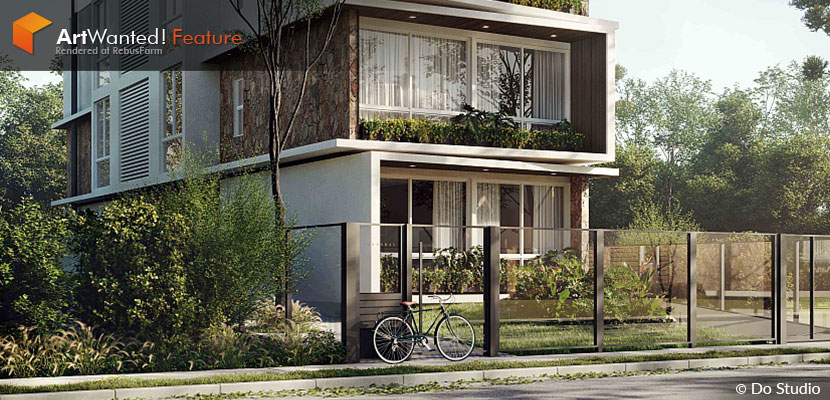
There are countless reasons people start their own business: a more flexible schedule, full financial and creative control, the ambition to make a name for themselves. When Brazilian architect and 3D artist Gustavo Görgen joined forces with his friends Marina Capalonga and Eduardo Possamai to found Do Studio in 2019, he was above all driven by the wish to be part of something bigger than himself – a common goal, a shared vision, and the belief that collective efforts surpass individual ones.
We sat down with Do Studio's three founders to discuss their joint venture and deep dived into one of their most recent projects, the 'Edificio Varandas'.
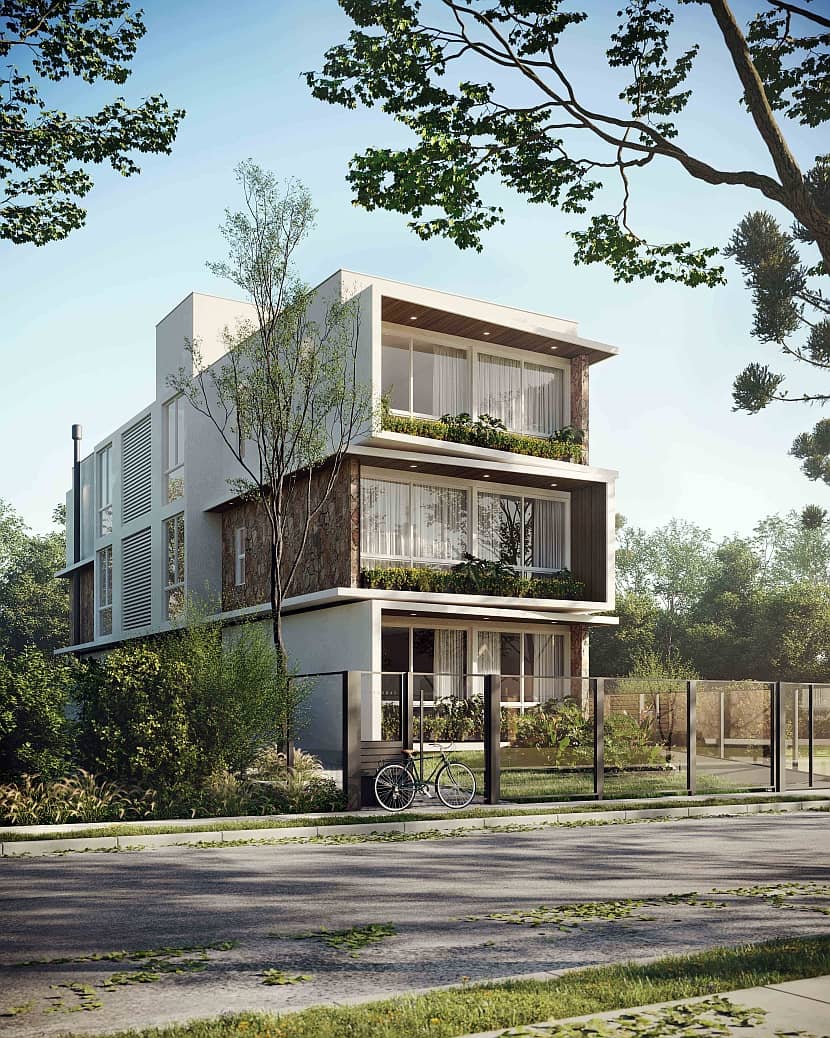 Located in the Brazilian mountains, the 'Edifico Varandas' was designed in accordance with its environment.
Located in the Brazilian mountains, the 'Edifico Varandas' was designed in accordance with its environment.
Hi Gustavo, thanks for joining us! To our delight, also joining us are Marina and Eduardo, welcome to all of you! For starters, please introduce yourself to our readers.
Gustavo: Hi everyone, how are you doing? First of all, I would like to thank you and the entire team at Rebus Render Farm for this opportunity to share our work with your community.
Now for me, my name is Gustavo Görgen, I am 26 years old and currently live in Lejado, a small city in southern Brazil. Together with Marina and Eduardo, my dear friends and business partners, I run Do Studio. Besides CGI, I am a huge music fan, rock 'n roll in particular, and I even tried to assemble my own rock band in my late teens.
Eduardo: Hey, my name is Eduardo Possamai, I am 26 years old and from Lajeado as well. I graduated in architecture and urbanism with the other founders of Do Studio in 2019. I worked for a long time with residential architecture and executions, outside the design area. But as the freedom that it provides always caught my attention I used to participate in competitions in teams and individually to be able to achieve this freedom.
I've always been a curious and investigative person, so since I started to get to know CGI I tried to learn, apply and talk to people who had the same desire.
Marina: I am Marina Capalonga, I too am 26 and live in Lajeado. Since co-founding Do Studio in 2019 together with Gustavo and Eduardo, I work as project manager, art director and finishing artist, and I am also involved in the architectural side of the company. I have always been a creative person, and I am also very much interested in sustainable technologies.
Do you recall when and how you first consciously encountered CGI?
Gustavo: Yeah, I discovered the world of CGI during my college days, although I had a rather limited perspective at the time. Initially, I only thought of 3D software as a visual aid, something to help with specific parts of a given project. Over the years, I got more and more into it, gradually developing a better understanding of CGI and its true potential. Today, I also appreciate archviz as a junction point between architectural knowledge and design realization, and I love the opportunities it provides.
Eduardo: Having worked in architecture from an early age, I was obviously aware of CG technology, and it was part of my college education as well. Once I had understood its advantages and the possibilities that 3D software allowed for, I started to dive deeper into it, and it eventually became a focal point of my studies. I already mentioned my inquisitive nature, and this thirst for knowledge is something we try to maintain and cultivate within the studio to this very day!
Marina: When I first encountered CGI at college, I would have never imagined it becoming my future career – but here we are! We started Do Studio right after our graduation as a space for us to experiment and develop our creative potential, which quickly led to more growth, and eventually, amazing job opportunities.
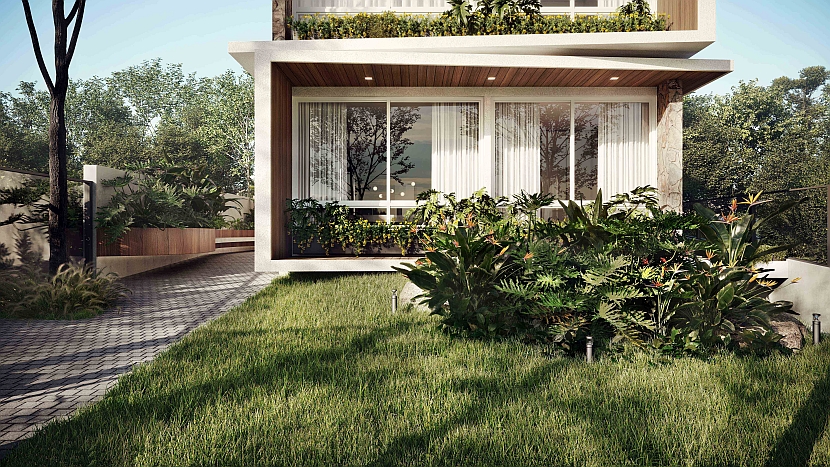 Going green: the artists at Do Studio make a point to incorporate a lot of vegetation in all of their designs.
Going green: the artists at Do Studio make a point to incorporate a lot of vegetation in all of their designs.
When and why did you then decide to pursue a professional career as a 3D artist?
Gustavo: The first time I thought of CGI as a viable career option was in 2018, when I started doing rendering jobs for some of my classmates. The quality of my work was improving further, and, at the same time, I was earning some money. Meanwhile, the practical experience I had gathered working at various architectural offices led me to two crucial realizations: first, architectural work involves a lot of bureaucracy; and second, I find that to be very boring!
The CG industry, in contrast, seemed more like the programming or software market, governed by fewer rules and regulations, and more open to new ideas. When we founded Do Studio in 2019, our immediate plan was not to run a profitable business operation. But then I lost my desk job in 2020 when the pandemic hit, and I decided to dedicate 100 % of my time to CGI and our studio.
Eduardo: I had always considered this field a potential career path. To me, it seemed like it could open doors in many different areas, and it allowed for creative freedom, which I liked. Similar to Gustavo, I helped out my classmates with some of their 3D work during college, and later worked as a tutor in design courses. Once I noticed how many projects had difficulties communicating ideas, I truly understood the importance of 3D.
Marina: These classmates Eduardo and Gustavo mentioned helping out…well, I was one of them! Since they were so proficient at renderings, a lot of my initial work for the studio consisted of graphic design, administrative tasks, and other loose ends. However, encouraged by my colleagues, I developed myself as a finishing artist and art director over time. Basically, the guys told me we needed someone and thought I would fit that role perfectly, and I was like "sure, why not?" So, I never decided didn't decide to become a 3D artist, it just happened.
So the three of you were classmates! Please tell us a bit about your college background and CG training.
Gustavo: Yes, we all graduated with a degree in architecture and urbanism. In terms of CG, I have an extensive background in Photoshop, having worked at a photo studio for five years during my adolescence. I also took Ander Alencar's Rendermind course (now Oficina 3D), which helped me to greatly improve the quality of my renders.
Eduardo: As an undergrad, I took several courses on representation, architecture, and design, and I made a point to apply these lessons in my day-to-day life in a practical way.
Marina: I took some courses on graphic presentation and rendering at college, and as I have mentioned, I have learned a lot more since then. All three of us also continue to study and learn every day, always looking for new tools and ways to improve our respective areas at the studio.
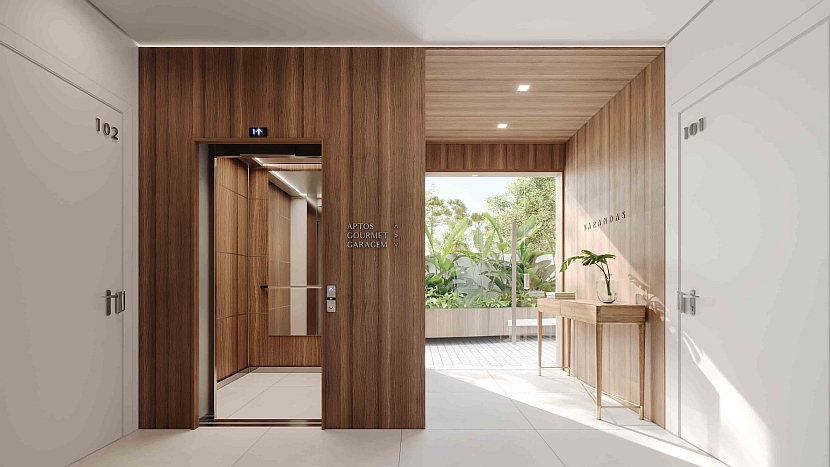 Fluent design: the entrance area and the apartment share an aesthetic language.
Fluent design: the entrance area and the apartment share an aesthetic language.
Can you tell us a bit about your personal history with architecture and architectural visualization? Where does your fascination stem from?
Gustavo: That is a tough question to answer. For me, it probably started with drawing, which I really liked. A teacher recommended studying architecture, and although I had doubts at times, I gave it a shot and stuck with it. In the process I discovered things like design and photography, then CGI was the great unifier, allowing me to bring together these different areas and share my vision of the world. In a lot of ways, it is like drawing, only in 3D.
Eduardo: Before college, I never thought I would work with architecture, let alone as a 3D artist. What captivated me about architecture is the ability to take pure thought and make it a tangible reality, like a plan or a design ultimately becoming something that directly affects the way we live. This motivates me a lot, and witnessing this in our work never fails to make me very happy.
Marina: To be honest, when I first chose to study architecture, I was not sure if it would really click with me. And even though there were times I thought about giving up, it all started to make a lot more sense to me eventually. Architecture is a realm of so many possibilities, and combined with CGI it becomes even less limited!
Is there a part of CG-related work you particularly enjoy? For what reasons?
Gustavo: My areas of expertise are post production, general aesthetics and photography. I really enjoy camera work, finding the best angles for a 3D model is very fun to me.
Eduardo: I like watching the creation of an image from start to finish. I enjoy striving for photorealism, and always try to extract as much detail as possible when modeling. I also greatly enjoy the relationship with clients and collaborators, I have an easy way of communicating and relating to people.
Marina: Art direction and photography, which is what I currently do! I have always liked photography and have been around cameras since I was young. I believe my experience, even if only as an amateur photographer, has increased my aesthetic sensibilities and improved my work as an art director and finalizer.
At this point, Marina and Eduardo have to leave, thank you both so much for taking the time. Fortunately, Gustavo remains with us a bit longer, so let us dive deeper into the work of Do Studio. Please tell us more about the company's history, your field of work and general philosophy. When and under what circumstances was the studio established?
Gustavo: The idea of starting my own company first arose when I was doing more and more jobs for my classmates. I had always wanted to create something bigger than myself, like a band, a team that works towards a greater cause. My sister and her husband encouraged me to act on this idea, and they also helped come up with the name. The "do" perfectly encapsulates our essence as a studio: instead of overthinking or making excuses, we make things happen, we simply "do" it.
To join me on this adventure, I recruited my roommate Eduardo, who is not only a great friend, but a very capable and responsible man. He believed in me and my crazy idea. Since we also needed someone with a greater sensibility for the small things, I invited Marina, a great person with a big heart, and now my girlfriend as well as a business partner.
With this triad formed, we started to do small jobs in CGI and branding design, with most of our clients being friends and classmates. We went through our fair share of growing pains, but we kept pushing forward, knowing that our combined efforts would lead to bigger and better things than we could achieve on our own. This sentiment has only grown stronger over time, and we are insatiable in our desire to do our best work every single day. Today, our team has three more people with us: Milena, Mariana and Marcelo. And we are just getting started!
What services do you provide?
Gustavo: We provide the following four principal services: still images, 3D animations, 3D floor plans, and virtual tours. In addition, since Nina, Edu and I are also architects, we offer additional services such as interior design, landscaping, and lighting design. Finally, we also do graphic design work to help clients make the best use of their images.
Who are your clients and target audiences?
Gustavo: We experimented a lot with different audiences but as of today, we mainly focus on real estate developers and designers. Occasionally, we produce images for architects as well.
 The compact apartment interior is comfortable, yet sophisticated.
The compact apartment interior is comfortable, yet sophisticated.
What is your exact position at Do Studio? What are your main responsibilities and daily tasks?
Gustavo: Edu, Nina and I are all co-founders, but for a more accurate job description, I nowadays call myself an art director. I provide feedback and quality control for all images we produce in-house, and am also involved in the finalization process, camera work and illumination in particular.
Edu takes care of all commercial and financial aspects of running the studio. He is responsible for budget proposals and also makes sure we are actually paid at the end of the month. On an operational level, Edu works on the finalization of the images, reviews, and feedback on our processes daily. He is very outgoing and keeps things moving on the backstage.
Nina is our project manager and finishing artist. She keeps our clients up to date about their projects and does post-production for all our images. If needed, she also helps out with other parts of the production process.
Besides these more individual responsibilities, we all are equally involved in creative direction. For every project, we sit down and discuss the best way to move forward, both conceptually and organizationally. It is very important to us and our work flow that we make these decisions unanimously!
Is there a specific design philosophy or architectural school of thought you adhere to? What or who inspires you as a 3D artist?
Gustavo: We greatly appreciate the Brazilian modernist school of architecture: Lina Bo Bardi, Paulo Mendes da Rocha, Oscar Niemeyer, and Affonso Reidy. We also of course admire Mies Van der Rohe and Le Corbusier, so yeah, we do enjoy classic modernist architecture. The simplistic approach of modernist architecture has influenced our own work, we often work with clean lines and place our focus where it really matters, on the details and the final quality.
On the other hand, we equally enjoy more contemporary architecture, such as the work from Foster and Partners, and Zaha Haddid. To name a few more Brazilian companies, there are Bernardes Arquitetura, MNMA Studio, Studio Guto Requena, Studio MK27, and many more.
Last but not least, I personally love "soft" design. These images we see around the internet that use soft lighting, fewer materials and objects – it's like music to my eyes.
On your website, you express concern about your role for the planet, a rather rare point of discussion in our line of work. Can you elaborate on this? How environment friendly is the CG industry and what can we do as a community?
Gustavo: We think about this a lot, since we are somewhat right in the middle of this dilemma, you know? Working within the CGI and the real estate industries has the potential to make a real difference for the planet; as architects, we have the power to show the world we want. Other times, it feels like we are just helping to maintain the status quo. There are no simple solutions, but I still feel we have a responsibility.
What can we do, then? Well, one small but effective strategy we employ when designing is to deck out the environment with plenty of greenery, no matter if the original concept for the environment had vegetation or not. Trees lining the sidewalk, plants visible on the façade of a building – what we call "urban niceties" in urbanism. The greener we show the city in our visuals and renders, the more likely people are to demand city planners and constructors to realize what they saw in the images.
This is just a small example, of course, in the medium or long term we ideally would power our computers only with renewable energy, and use less resources overall: less paper, fewer plastics, less gas. Another thing is to simply talk about this cause more, as it spreads awareness and attracts likeminded people. After all, it affects everybody and we all have to do our part, the CG industry is no exception.
Let us talk about your work in more detail, namely the 'Edificio Varandas', the three-story modular residential building you submitted to our campaign. Can you first tell us about the origins of the project?
Gustavo: Sure, let's go! This job came to us in early 2021 through a great client who was starting a construction company and was looking for a partner. We talked a lot about architecture and how it can better serve people, and we soon discovered we were on the same frequency. We shared core beliefs not only about architecture, but also regarding company philosophy.
Since there was a lot of mutual trust, we had a great amount of creative freedom, from branding to internal projects. I believe this relationship with our client to be a key factor in the project turning out so well.
Please describe the basic concept and central idea for the design of the building.
Gustavo: The site is located at a popular tourist destination in Brazil and is thought to be rented for short periods of time. The apartment therefore is compact, accommodating the needs for shorter stays. It has a living room with an integrated kitchen, two bedrooms, and two bathrooms. The complex also has parking, outdoor seating areas, and a gourmet space right next to the greenery.
Our client wanted a living space that was comfortable, yet sophisticated, a place where people would find calm and tranquility. We wanted the architecture to interact with its surroundings at all times, so that no matter where you are, you will not only be looking at the landscape, but interact with it. The building's main entrance and the apartment itself also have a very interesting relationship: they share a unique language and consistently "talk" to each other. The same holds true for the vegetation on the site, this too was to relate to both the building and the environment.
What were some of the challenges you had to overcome?
Gustavo: Since the package included images, animations, blueprints, and branding, the biggest challenge was for all these separate disciplines to come together as a coherent whole and interact with each other properly. We tried to optimize our files, used a lot of references and tested until we got the result we wanted.
This project actually marked our first foray into animation. Using 3ds Max and Corona Renderer, we wanted to create something beautiful, yet conceptually sound, something that would work as a commercial video. It was challenging, but we really enjoyed the process and, considering this is our first animation, I personally think the result is very good!
How long did it take you to complete the project?
Gustavo: From the beginning of the creative process to completion, it took us about four months. After delivering the final package, we continued to make some additional images for dissemination.
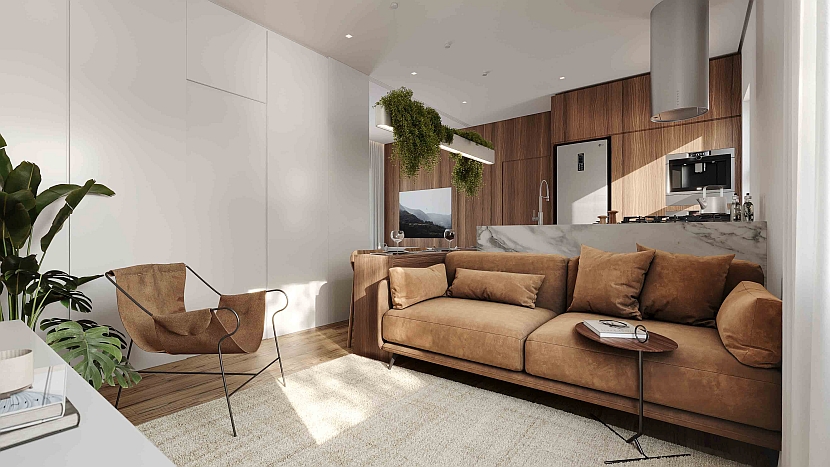 The spacious living room, with the integrated kitchen visible in the background.
The spacious living room, with the integrated kitchen visible in the background.
Talk to us a bit more about the interior, its style, and your choice of colors, materials, lighting, and overall composition.
Gustavo: As the site is located in the mountains, we sought to go with a contemporary style, with neutral colors and textures for a warm and tranquil atmosphere. We chose designer furniture with a similar style to further this effect. We set the scene towards the end of the day and adjusted the lighting accordingly: a warm and gentle tone, to convey the feeling of a winter day in the mountains.
Can you briefly walk us through your development/production process step by step?
Gustavo: At the start of our creative process stood an internal meeting, in which we discussed references, goals, and expectations. Since it was a rather complex project involving several disciplines, we also defined how to conduct the entire process early on. Following this kick-off, we started the external and internal modeling separately to optimize the files. When we finished the modeling, each image went through the artistic process of texturing, lighting, and composition.
At this point we made a first delivery to the client, after which we took to the development of the 3D plans and branding, all according to the feedback we received. Having made all of the requested changes, we followed up with a couple more loops until the final delivery. Once approved, we started the assembly and finalization of the 3D animation.
What software did you use to create this particular project? Any plug-ins you found particularly helpful?
Gustavo: We use 3ds Max for modeling and Corona Renderer for rendering, post-production was done in Photoshop. For the animation, the Phoenix FD plug-in was invaluable, and we did the post in Premiere.
 The outdoor seating area provides ample opportunity for relaxation.
The outdoor seating area provides ample opportunity for relaxation.
What has the feedback been like so far and how satisfied are you with the results yourself?
Gustavo: As an emerging studio seeking to improve every day, we greatly value customer feedback, and our own satisfaction is directly tied to that of our clients. That said, we are very pleased the project was so well received!
What is one thing you have learned from this project that you can share with us?
Gustavo: The main thing we learned during development was file optimization. We worked a lot with proxies, xrefs, and low poly objects. For the animation, we also did a round of texture optimization.
In terms of studio management, the 'Varandas' project also served as an important case study, as it allowed us to analyze and evaluate our internal processes. Going forward, we will use this information to further improve our workflow and work even more efficiently.
Please tell us about your experience with RebusFarm. Is there anything you especially like about our service?
Gustavo: RebusFarm is our rendering service of choice, it is reliable, intuitive and user-friendly. And your support team is amazing; whenever we had questions or encountered difficulties, we were immediately attended to and had our problems solved.
In your estimation, how much time do you save on average by rendering with RebusFarm as opposed to using your own machine?
Gustavo: Using the Varandas project as an example, we easily saved six hours per scene, maybe more. These are highly detailed images, after all, including a lot of vegetation and such. Not to mention the animation, that alone would probably take us a couple of days to render ourselves.
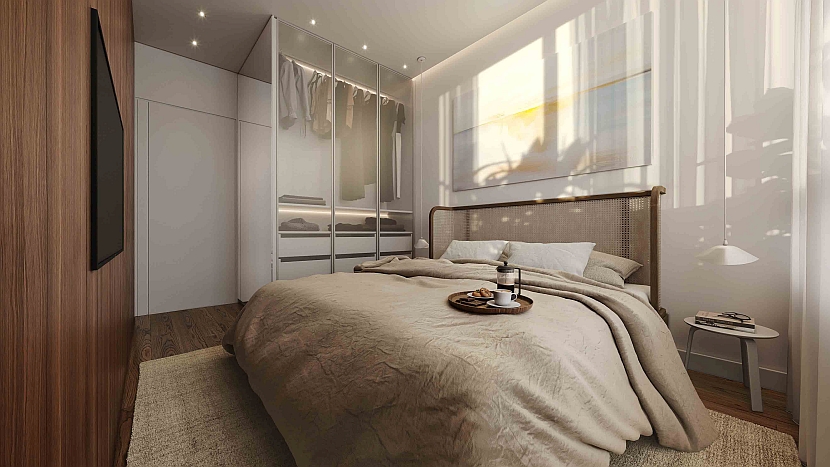 Breakfast in bed? Just Do it!
Breakfast in bed? Just Do it!
In closing, is there anything else you want to say? Any plugs, shoutouts or upcoming projects you would like to mention?
Gustavo: Once again, thank you so much for having us! We are avid readers of your blog and were thrilled to be featured ourselves.
As a studio, we are always striving to evolve, with every job providing a unique and exciting opportunity. This year, we are branching out into new areas: we are working in branding and product rendering, and we are tapping into the metaverse as well. We will share the fruits of our labors through our social networks. And speaking of networking: we are always open to discussing experiences and exchanging ideas, so feel free to hit us up for a chat anytime.
Gustavo, thank you so much for taking the time and all the best in the future.
---
Keep up with Do Studio and their work here:
How to join ArtWanted!
Do you want to get featured in our ArtWanted! campaign and win 250 RenderPoints on top? Submit your work, rendered at RebusFarm, to 该邮件地址已受到反垃圾邮件插件保护。要显示它需要在浏览器中启用 JavaScript。! Visit our RebusArt Page for more information.
>> Read more articles on our blog
Get started with your own renderings
